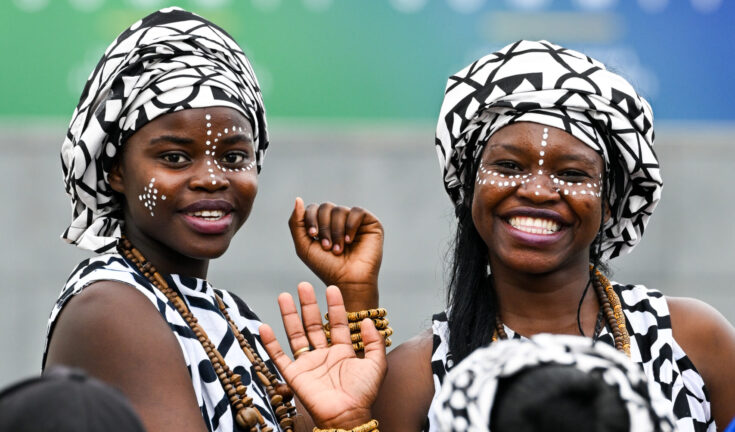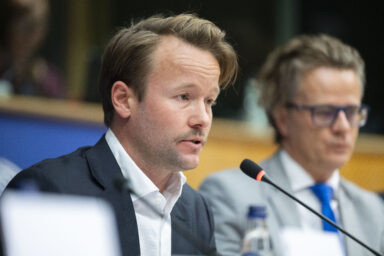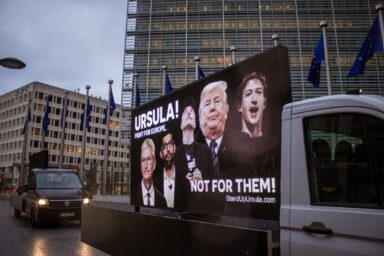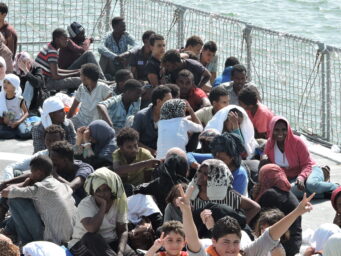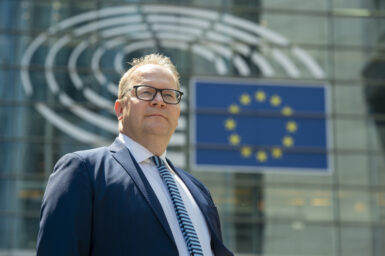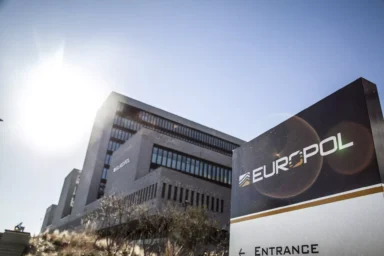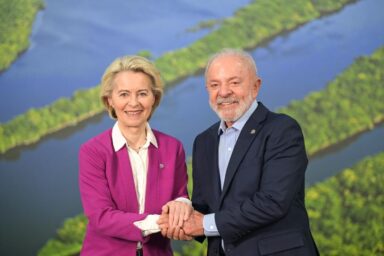Forget the summit selfies. The African Union-European Union big meet-up in Luanda is really about down to earth issues — sometimes literally so. Europe wants young workers and green minerals; Africa wants debt relief and factories that hum after dark.
The summit (kicked off in Luanda, Angola’s capital on Monday 24 November, concludes on Tuesday) offers a rare chance to reset a partnership that too often drifts between lofty speeches and meagre delivery. Since the first gathering in 2000, both blocs have spoken of a “strategic relationship”, yet the gulf between rhetoric and reality has widened. Power imbalances persist, implementing agencies struggle, and public scepticism swells on each side of the Mediterranean.
European Centre for Development Policy Management is a European think-tank heavily invested in the relationship of the two continents. Geert Laporte, the institutuon’s associate, fears another round of set-piece diplomacy. Previous summits, he noted in his article written for ECDPM’s compendium focusing on the summit, produced “euphoric declarations” that changed little on the ground. “To break this cycle of ritualised summitry,” Mr Laporte argues, “both parties must use the time between summits to address their real disagreements.” That means tackling irritants such as trade preferences, visa regimes and procurement rules before leaders assemble, not after.
Mr Laporte wants a bigger table as well as a clearer agenda. Civil-society groups, start-ups and think-tanks rarely feature in official exchanges, though they implement much of what gets agreed. Their inclusion could lend credibility and inject fresh ideas into a conversation now dominated by diplomats who rotate posts every few years and see success in communiqués rather than contracts.
You might be interested
Meetings in search of substance
Migration shows how ritual can trump results. Each crisis—Syrian refugees in 2015, the pandemic in 2020, Ukraine now—reboots the same argument: Europe seeks deterrence, Africa demands visas. Anna Knoll, head of migration and mobility at ECDPM, wants a broader frame. “A more durable framework,” she says, “would recognise mobility as an economic and strategic dimension of the partnership, central to the future competitiveness and demographic sustainability of both continents.”
Demography supports her case. Europe is ageing; Africa adds a labour force bigger than India’s every decade. Linked by coherent schemes for study, apprenticeships and circular work, the two markets could profit together. Europe’s Talent Partnerships and the AU’s Free Movement Protocol provide legal scaffolding. The summit can connect them to an industrial vision that turns population trends into productivity gains.
Leaving the debt issue in the margins will only undermine the AU-EU partnership and its credibility. — Karim Karaki, European Centre for Development Policy Management
That vision demands tight sequencing. Training nurses for European hospitals, for instance, should rest on matching investments in African medical schools. Without that back-end, Europe raids skills while Africa bleeds capacity. Equally, Europe could tie residence permits to return incentives that help migrants set up firms at home. Mobility then becomes development, not flight.
Debt, development and credibility
African leaders insist that any grand plan must start with finance. Many governments spend as much servicing loans as they do on health. Karim Karaki, head of economic recovery and transformation at the same think tank, says success of the EU’s €150bn Global Gateway package hinges on “the debt and investment nexus”. He urges leaders to dust off the Sevilla compromise, which sketched tools such as Climate-Resilient Debt Clauses and debt-for-development swaps but never scaled them.
“Leaving the debt issue in the margins,” Mr Karaki warns, “will only undermine the AU-EU partnership and its credibility.” His fear is political as well as economic. Beijing often funds roads that Brussels only studies—proof, he says, that donors must move from feasibility reports to pouring concrete. Europe’s promise of high environmental and social standards carries weight only if projects actually break ground.
The choice of sectors matters too. Mr Karaki lists critical raw materials, health, energy and digital services as fields where investments “strengthen mutually beneficial partnerships”. Europe needs lithium, cobalt and rare earths for its green transition; Africa seeks factories, jobs and export revenue. “The EU desires to forge mutually beneficial and not extractive partnerships, which is the sine-qua-non condition to build strategic partnerships that can strengthen the EU’s open strategic autonomy,” he says.
Digging for value
Poorva Karkare, a senior policy analyst, links minerals to skills. Africa owns rich deposits yet captures little value: ore sails from Mombasa; batteries dock at Rotterdam. “Early successes should then be scaled regionally and continentally,” Ms Karkare suggests, “treating skills provision as a regional public good rather than a national effort.” Mining needs geologists and engineers; smelting calls for chemists and metallurgists—talent better trained in clusters than scattered colleges.
Europe already funds dozens of training schemes, but Madrid rarely speaks to Warsaw, let alone Abidjan. Consolidating such programmes under one AU-EU skills compact could cut duplication and match graduates to plants. Brussels might channel part of its Horizon Europe research budget into African institutes that conduct mineral-processing experiments on site, not in distant laboratories.
Electricity should be treated as a catalyst for growth, not just a social good. — Poorva Karkare, ECDPM
For Europe the prize is security of supply. The Critical Raw Materials Act obliges member states to diversify imports. Long-term contracts with African refiners would hedge political risks, while joint ventures lift African earnings. A pilot lithium-to-battery corridor, stretching from Zimbabwean mines to Namibian cathode factories and on to Portuguese gigafactories, could show what integration means in practice.
Powering progress
Minerals and factories, however, require power. Half of sub-Saharan Africa lacks electricity; firms that do connect pay tariffs triple those in Europe. The deficit repels investors and shackles local industry. China finances many dams and grids yet struggles to collect bills from state utilities already drowning in debt. Europe’s Global Gateway pledges €150bn for African infrastructure. The challenge is to shift from planning to wiring.
Policy should favour productive use. Extending wires to remote hamlets may win applause yet yields scant economic return. Ms Karkare offers a sharper sequence: energise clusters of agro-processors, garment makers and data centres first; households will follow as incomes rise. “Thus, electricity should be treated as a catalyst for growth, not just a social good,” she argues, “that is, power the economy, and people will power their homes.”
Renewables help but need financing models that match cash flows. Solar farms can undercut diesel in industrial parks; geothermal wells in Kenya run uninterrupted factories. The EU could bundle grants, guarantees and commercial loans into blended packages that lower risk without crowding out private capital. Success would marry green electrons, mineral beneficiation and skilled jobs in one virtuous circuit.
Peace-and-security architecture
Even the best economic scheme wilts amid war. Conflicts worldwide have doubled in five years, note other ECDPM’s experts, Sophie Desmidt and Volker Hauck. Military budgets set records while aid to governance shrinks. “The wars in Ukraine, Gaza and Sudan have highlighted fractures in the AU-EU peace and security partnership,” they observe. Europe sees Africa as battlefield and buffer; Africa resents lectures after Libya, Wagner and vaccine hoarding.
Both sides now talk of “shared responsibility”. That phrase needs substance. The AU’s doctrine of subsidiarity gives regional blocs first call on crises. Europe could channel predictable funding to African standby forces once the United Nations verifies oversight. Resolution 2719, which opens the door to UN financing for African peace operations, awaits pilots. The summit can list missions, timetables and budgets rather than launch another study.
The wars in Ukraine, Gaza and Sudan have highlighted fractures in the AU-EU peace and security partnership. — Sophie Desmidt, Volker Hauck, ECDPM
Representation also matters. African diplomats campaign for permanent seats on the Security Council; Europeans voice support yet duck a concrete plan. An AU-EU caucus could table a joint reform proposal at the UN’s next high-level week, showing that security reform and geopolitical equity travel together. Shared votes cost nothing yet signal trust.
Convergence, not coincidence
Collectively these three strands—mobility, finance and minerals linked to energy—form a coherent bargain. Europe obtains labour, inputs and allies for its twin transitions: digital and green. Africa gains investment, technology and market access to industrialise at home rather than export raw commodities and talent. Each element reinforces the others. Workers trained under mobility schemes can staff battery plants powered by new grids financed through restructured debt.
Delivery will test resolve. Monitoring units could track milestones, publish audits and trigger mid-course corrections. Parliaments, not just presidents, should scrutinise contracts. Civil-society watchdogs could flag environmental lapses early. All this demands patience—a scarce resource in both electorates—but beats the cost of another decade of disappointment.
Luanda is no stranger to grand gatherings. In 1975 diplomats met there to discuss decolonisation; peace arrived only after decades of war. History suggests that progress comes when interests align and leaders stay focused once cameras depart. The AU and EU need less ceremony, more sweat. They possess the agenda, the cash and the talent. What they lack is the habit of keeping promises. As Geert Laporte writes, “breaking that cycle would be the summit’s most strategic achievement“.
